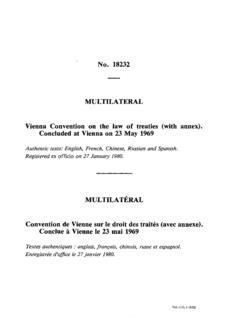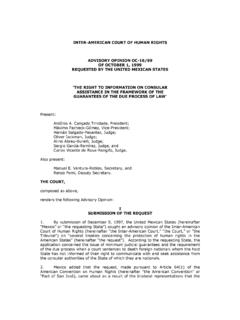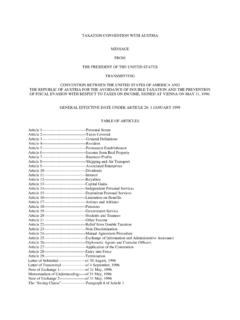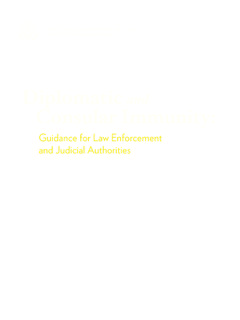Transcription of The principal purpose test in tax treaties under …
1 The principal purpose test in tax treaties under BEPS 6 H. Kok The principal purpose Test in Tax treaties under BEPS 6 Reinout Kok*In report 6 of the BEPS action plan, Preventing the Granting of Treaty Benefits in Inappropriate Circumstances, the Organisation for EconomicCo-operation and Development (OECD) proposes (amongst others) to include a principal purpose test (PPT) in tax treaties . under this test a treatybenefit shall not be granted if it is reasonable to conclude that obtaining that benefit was one of the principal purposes of any arrangement ortransaction (subjective test), unless it is established that granting that benefit in these circumstances would be in accordance with the object andpurpose of the relevant provisions of the treaty (objective test). The subjective test is, from the viewpoint of the tax authorities a relatively easy objective test, however, can provide for some relief for taxpayers.
2 In this article the PPT is being investigated and discussed. Especially, attentionis given to the objective test. An attempt is being made to develop practical guidance to interpret the PPT, based on Dutch case law and item 6 of the BEPS project is about Preventingthe Granting of Treaty Benefits in InappropriateCircumstances . The report on this topic, that waspublished in October 2015 (hereafter: the report), containsvarious proposals. In this article one of the proposals willbe investigated and discussed, namely the introduction ofa so-called principal purpose test (PPT) in tax article is built up as follows. In section 2, themeaning of the term treaty abuse will be discussed. Themain characteristics of the PPT will be outlined in section3. The PPT contains a subjective test (what was the aim ofthe taxpayer using a certain arrangement?) and anobjective test (would granting the treaty benefit defeat the object and purpose of the relevant treaty provision?)
3 These two tests will be investigated in sections 4 and article will be concluded with a short summary insection ABUSEIn the report a distinction is made between two ways ofabuse under a tax treaty:(1) The circumvention of provisions of the treaty itself.(2) The circumvention of domestic law example of the first category is the use of conduitcompanies. For example, an enterprise in country A wantsto invest in an enterprise in country B. However, there isno tax treaty between country A and country B. There is,however, a tax treaty between country B and country C,but application of that treaty is restricted to residents ofcountry B and country C. The enterprise in country A triesto circumvent that restriction by setting up a conduitcompany in country C, and invests via that conduitcompany in the enterprise in country example of the second category is trying to invoke atax treaty to avoid application of domestic CFC-provisionsor domestic thin capitalization legislation.
4 Also notapplying the domestic abuse of law doctrine (fraus legis) inan international (treaty) situation is a good example. Forexample, the Dutch Supreme Court has ruled that certainfact patterns that entirely took place in the Netherlandscould be challenged with the abuse of law doctrine, butthe same fact patterns, but now involving foreign (treatyprotected) companies, could not be challenged with theabuse of law *Prof. dr. Reinout Kok, Erasmus University Rotterdam and EY Dutch version of this article, Enkele aspecten van de principal purpose test (written on the basis of the draft report published in 2014) was published in WFR 2015 Dutch Supreme Court has ruled in HR 15 Dec. 1993, nr. 29 296, BNB 1994/259, annotation Bartel, HR 29 Jun. 1994, nr. 28 734, BNB 1994/294,conclusion Advocate-General Verburg, annotation Wattel and HR 15 Mar. 1995, nr. 29 531, BNB 1995/150, annotation Wattel, that fraus legis could not beARTICLE406 INTERTAX, Volume 44, Issue 5 2016 Kluwer Law International BV, The Netherlands3 THE principal purpose Proposed Article X(7)In the report, the PPT is Article X(7) of the OECD Modeltax convention.
5 The proposed Article X(7) reads asfollows:Notwithstanding the other provisions of this Convention, abenefit under this Convention shall not be granted in respect ofan item of income or capital if it is reasonable to conclude,having regard to all relevant facts and circumstances, thatobtaining that benefit was one of the principal purposes of anyarrangement or transaction that resulted directly or indirectlyin that benefit, unless it is established that granting thatbenefit in these circumstances would be in accordance with theobject and purpose of the relevant provisions of this can see two tests in order to determine whether thebenefit of the treaty should be granted in a specific first test is the subjective test. Was obtaining thebenefit one of the principal purposes of any arrangementor transaction that resulted directly or indirectly in thatbenefit? If this is the case, the treaty benefit will not begranted, unless and this is the objective test grantingthat benefit would be in accordance with the object andpurpose of the relevant treaty provision(s).
6 This is in line with the guiding principle of of the Commentary on Article 1 of the OECD ModelConvention:A guiding principle is that the benefits of a convention shouldnot be available where a main purpose for entering into certaintransactions or arrangements was to secure a more favourabletax position and obtaining that more favourable treatment inthese circumstances would be contrary to the object and purposeof the relevant X(7) is the codification of the concept of frausconventionis that is for example well known in Dutchprofessional tax literature. A good definition of frausconventionis that can be found in Dutch doctrine is:Acting in fraudem conventionis in tax law, is when ataxpayer uses a scheme/transaction with the sole, of or at least,essential purpose to obtain the desired tax consequences on thebasis of the relevant tax treaty, whilst that scheme/transactiondefeats the object and purpose of the one compares this definition with the proposedArticle X(7), one can clearly recognize the similaritiesregarding the two tests .
7 There is, however, a relevantdifference in the subjective test. In Article X(7) thesubjective test is met if one of the principal purposes isobtaining the tax benefit, whilst under the definition offraus conventionis, that is only the case if the sole oressential purpose was obtaining the tax benefit. From theviewpoint of the tax authorities the subjective test underArticle X(7) is therefore more easy . This will be discussedin more detail difference is the following. Article X(7) isstructured in a different way than the definition of frausconventionis that was given above. In Article X(7), themain rule is the subjective test. If the principal purpose ofan arrangement/transaction is obtaining the treaty benefit,the PPT applies. The objective test (object and purpose ofa treaty) is only an exception to the main rule. under frausconventionis the subjective and objective test are equallyimportant, , they are not modelled as a main rule andan exception.
8 This difference between the PPT and frausconventionis could result in different outcomes in it might be difficult to determine whatthe object and purpose of a treaty and/or treaty provisionsare. In such case, under the PPT, a taxpayer cannot use theobjective test in order to safeguard the benefits of thetreaty, because in order to invoke that exception it has tobe established that granting the benefit would be inaccordance with the object and purpose of the relevanttreaty provision(s). In such case, applying frausconventionis on the contrary would likely be said, the concept of fraus conventionis has beendiscussed in Dutch professional tax literature. It isnoteworthy that the Dutch Supreme Court, so far, has notapplied the concept of fraus conventionis. Reference can bemade to its decision of 11 May this case, theplace of residence of a Dutch company was migrated toBelgium just before the company went into the Belgium-Dutch treaty, this implied that theliquidation proceeds (in the hands of the shareholder)could not be taxed in the Netherlands.
9 The SupremeCourt ruled that since the treaty referred to the place ofresidence of a company for certain tax consequences, itcould not successfully be argued (by the tax authorities)that migrating a company to Belgium to obtain those taxbenefits, would be against the object and purpose of thetax treaty. It is, however, not fully clear whether theSupreme Court denied application of the concept of frausconventionis only in this specific case, or whether thedecision has a more general meaning, , that frausNotesapplied in a treaty situation because neither from the text of the treaty itself, nor from the clarifications of the contracting states it could be derived that it was intended thatfraus legis could be applied under the treaty on the arrangements at is made to the annex to the conclusions of Advocate-General Van Ballegooijen in the cases 39 223, 40 450, 40 451, 40 452 en 40 453.
10 The annex can be found inBNB 2007/36. The translation from Dutch into English is not 12 May 2006, nr. 39 223, BNB 2007/36, conclusion Advocate-General Van Ballegooijen, annotation S. van Weeghel. See also HR 14 Jul. 2006, nr. 42 522, BNB2007/42, annotation S. van principal purpose Test in Tax treaties under BEPS 6407conventionis will never be applied by the Dutch a Need for Article X(7)?It is a fair question whether Article X(7) does change thecurrent practice of treaty application. Lang has argued thattreaty benefits should not be granted if taxpayers actcontrary to the object and purpose of a his viewArticle X(7) does not have an independent legalsignificance but merely underlines the already evidentneed for interpretation to be based on the object andpurpose of the rules. Therefore, the rule is a mere hint forthe interpretation and totally expendable.


















